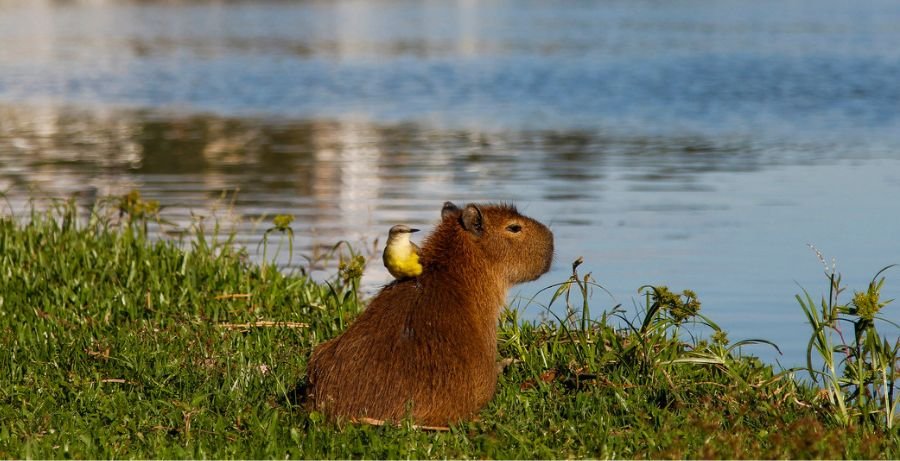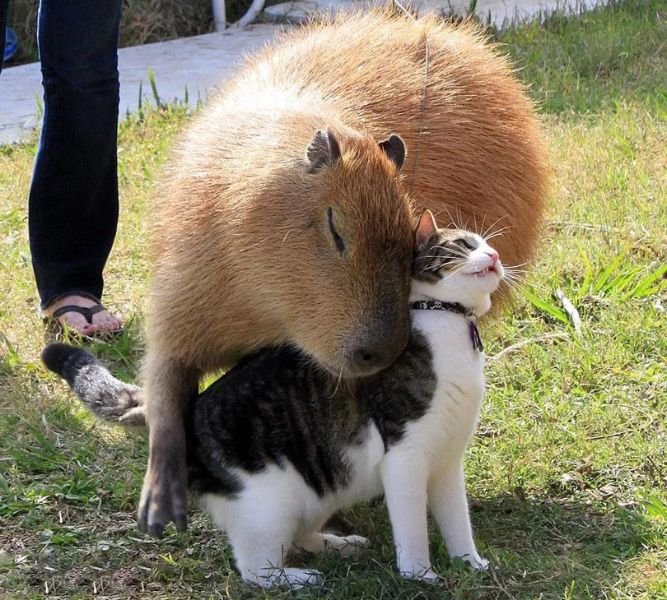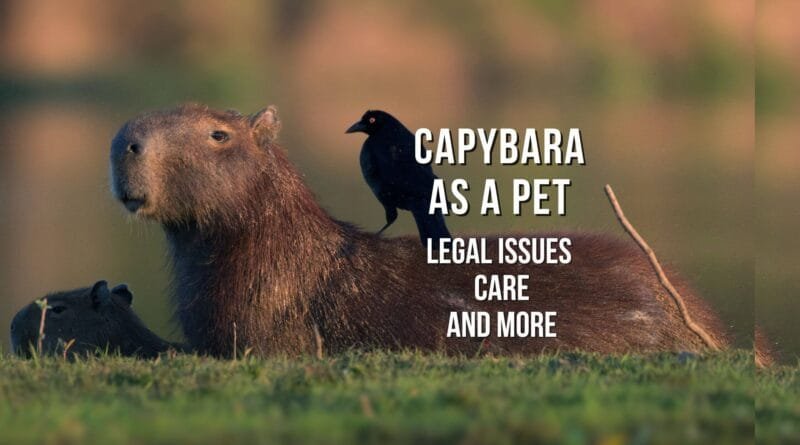Capybara as a Pet: Legal Issues, Care, and More
It may seem a bit strange to call the world’s largest rodent a pet, right? The fact is, some people are passionate about unusual pets, and that’s why we at Proto Animal always try to provide information about different animals to ensure their well-being. In this article, we’ll explore whether having a capybara as a pet is legally allowed, the necessary care, and the characteristics of this charming creature that has won over the internet and our hearts. Enjoy the read and have fun!

Image: National Geographic
Capybara (Hydrochoerus hydrochaeris)
As mentioned earlier, the capybara is the world’s largest rodent. Some say it looks like a giant guinea pig because it has the same friendly face as its smaller relative and is just as gentle and social. However, in terms of size and weight, they are quite different.
Adult capybaras can reach up to 176 lbs, measure 4.3 feet in length, and 2 feet in height. That’s more than the average weight of an adult human! This means that having a capybara as a pet is not simple and requires a lot of care. We’ll discuss this further in the article.
With dense, short, and thick brownish fur, they are semi-aquatic animals, which is why they are usually seen near rivers, lakes, or flooded areas. Except for some males who prefer a solitary life, capybaras are generally social animals and live in groups. They are herbivores and typically eat at dusk. They also eat a lot— a 88 lbs capybara can consume up to 8.8 lbs of grass per day
Wild Animal
The capybara is classified as a wild animal because it is native to untamed environments and has not been domesticated. These animals are traditionally found in South America, living in habitats ranging from tropical forests to swamps, always near bodies of water.
Although they are gentle and sociable, it is important to remember that capybaras are still wild animals, and their behaviors and needs reflect that.
Pet Animal
A pet is a domesticated or semi-domesticated animal that is kept primarily for companionship rather than for work, sports, or research. People keep pets for their unique qualities and characteristics that make them ideal companions.
This includes a variety of animals, from the more common dogs and cats to exotic animals like snakes and tropical birds. However, having a capybara as a pet is a serious commitment that requires proper care, time, attention, and resources to ensure the animal’s well-being.

Habitat
Capybaras are highly adaptable and are commonly seen in areas heavily altered by humans.
In some parts of the United States, such as Florida and Texas, capybaras have been spotted in the wild. There are concerns that they could become an invasive species, as they adapt well to warm climates and wetlands. This is why some states have strict laws regarding capybara ownership.
Legal Issues
Owning a capybara as a pet is regulated in the United States and varies by state. Some states allow it with a special permit, while others ban it entirely. Before considering a capybara as a pet, you should check with local wildlife agencies, such as the U.S. Fish and Wildlife Service or your state’s Department of Natural Resources.
Capybaras should only be purchased from licensed breeders. Do not buy them online or from unauthorized sellers, as this contributes to the illegal wildlife trade.

Agenor Tupinambá and His Capybara Filó on Social Media
Agenor Tupinambá is a farmer from Amazonas, Brazil, who became famous after sharing his friendship with Filó, his pet capybara.
Agenor is well-known in his region for always being seen with his beloved Filó. However, his videos are not just cute—they also raise awareness about the illegal wildlife trade and highlight the importance of preserving capybaras’ natural habitat.
His story brought attention to the debate over keeping a capybara as a pet, as he was later fined by Brazilian authorities for wildlife violations. This case highlights the legal and ethical challenges of having a capybara as a pet, especially when taken from the wild.
Caring for a Capybara as a Pet
As mentioned earlier, keeping a capybara as a pet is not an easy task. It requires both financial and personal investment from the owner.
A well-cared-for pet capybara can live up to 12 years, which is twice the average lifespan of a wild capybara. To provide the best care, it’s essential to recreate their natural habitat and meet their social needs.

What Kind of Space Does a Capybara as a Pet Need?
Why does owning a capybara as a pet require a financial investment? Simple: capybaras need a large space to live.
- You cannot keep them in an apartment, no matter how big it is.
- They must have access to water to swim—this can be a small pond, reservoir, or pool, but it must be at least 1 meter (3.3 feet) deep.
- They need a large grassy area to run around.
- They must have a shaded spot to rest.
Additionally, if you live in a warm state like Florida, Texas, or Southern California, your capybara as a pet will probably live outdoors most of the time. However, if you live in a colder region, such as the Midwest or Northeast, you will need an indoor heated space during winter, as capybaras are not suited for freezing temperatures.

Socialization
Capybaras are highly social animals that naturally live in groups—remember we mentioned this earlier? Because of this, a capybara as a pet living alone, without other animals for companionship, is likely to develop stress and depression.
Even if the owner is present and interacts constantly, the best way to keep a capybara as a pet happy is to have at least one other animal for companionship and play. Ideally, adopt two capybaras, preferably a male-female pair or two females, if possible.

Capybaras are known for being one of the friendliest and gentlest animals in nature. A quick internet search will show dozens and dozens of photos of capybaras playing with other animals—including cats, dogs, monkeys, turtles, and even birds hitching a ride on their backs. Because of this, it is essential not to raise a capybara alone, as its personality does not match solitude.

Adopting a wild capybara that has never had contact with humans is not recommended. Similarly, bringing home an adult capybara will make domestication and adaptation much more difficult and time-consuming. The ideal approach is to raise a capybara from a young age, and if done correctly, it can get along very well with other animals—even a cat, for example.
Remember: the most important thing is that your capybara does not live alone.
Diet
Like humans, capybaras cannot produce vitamin C naturally, so they need a diet rich in vitamin C or supplements.
They are herbivores and should have access to fresh grass, hay, and plant-based materials to help maintain their dental health.
They can also eat carrots, apples, yams, watermelon, corn, and a variety of fruits and vegetables.
Conclusion
If you plan to have a capybara as a pet, follow these guidelines, check your state’s legal requirements, and remember that it is not a simple task.
With the right care, you can happily live with your new furry friend!
See you next time! ♥




